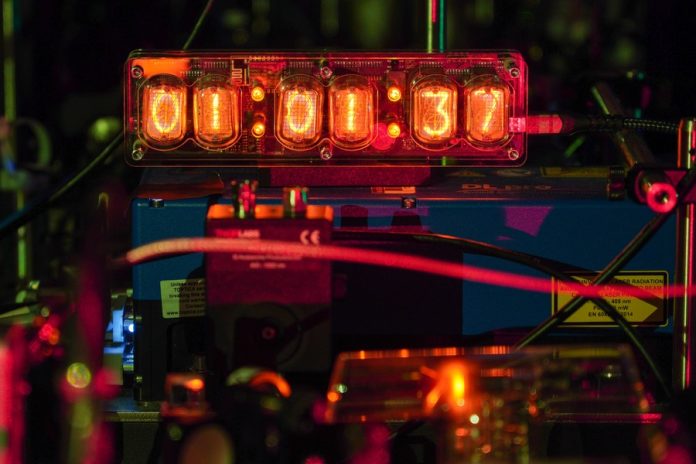
Every time you check your phone, make an online payment, or use GPS, you rely on one of humanity’s most precise tools: the atomic clock.
These clocks keep time not with ticking hands but with the steady vibrations—or “ticks”—of atoms.
Current atomic clocks use cesium atoms, which oscillate more than 10 billion times per second. Each tick is tracked using lasers tuned to those atomic vibrations, allowing incredibly precise timekeeping.
Now, MIT physicists have made a breakthrough that could make these clocks even more accurate.
Their new technique, described in Nature, doubles the precision of optical atomic clocks by reducing the fundamental “quantum noise” that blurs atomic vibrations.
This improvement could eventually make portable, ultra-precise atomic clocks possible—devices capable of detecting dark matter, predicting earthquakes, or testing the fundamental laws of physics.
Next-generation atomic clocks rely on faster-ticking atoms, such as ytterbium, which oscillate at optical frequencies—about 100 trillion times per second.
The faster the tick, the smaller the unit of time that can be measured.
But as accuracy increases, so does the challenge: quantum effects and laser instability make it difficult to measure these rapid oscillations precisely.
Back in 2020, Professor Vladan Vuletić and his team at MIT showed that quantum entanglement—linking atoms so they act collectively—could improve clock precision.
By entangling hundreds of ytterbium atoms with lasers bouncing between mirrors, they reduced the uncertainty in measuring atomic ticks. However, they were limited by the stability of the laser itself.
In 2022, the researchers developed a “time reversal” technique that enhanced their ability to detect differences between the laser and the atoms’ tick rates.
But at the time, they were still working with slower, microwave-based systems. Applying the same idea to much faster optical clocks remained a major challenge.
In their new study, the team figured out how to extend their quantum-enhanced methods to optical atomic clocks.
They found that a subtle effect—previously thought to be irrelevant—could actually help stabilize the laser.
When a laser interacts with entangled atoms, it slightly shifts their overall energy, even after the atoms return to their original state. This shift, known as a “global phase,” carries valuable information about the laser’s frequency.
“Normally, people ignore this global phase,” Vuletić explained. “But we realized it contains a record of the laser’s frequency shift—and we can use it to correct the laser itself.”
The team combined this discovery with their quantum “amplification” technique to make the effect strong enough to measure. The result was remarkable: they doubled the precision of their optical clock, allowing it to distinguish twice as many atomic ticks per second compared with the same setup without the new method.
This new approach, called global phase spectroscopy, not only improves accuracy but also simplifies the design of highly stable optical atomic clocks.
That could make them smaller and easier to transport. In the future, portable versions might be deployed around the world to monitor changes in gravity, detect underground movements before earthquakes, or even test whether physical constants vary across space.
“With these clocks, people are trying to detect dark matter and dark energy, and even test whether there really are just four fundamental forces,” Vuletić said. “Our method could help make these clocks transportable and deployable to where they’re needed.”
The work was carried out by researchers from the MIT-Harvard Center for Ultracold Atoms and the MIT Research Laboratory of Electronics, with support from the U.S. Office of Naval Research, the National Science Foundation, the Department of Energy, and DARPA.
In essence, by listening more carefully to the “ticks” of atoms, MIT physicists are helping humanity measure time—and the universe itself—with even greater precision.



